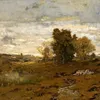



About the Artist
Master’s Palette
Reveal the unique color story behind each piece, helping you delve into the artistic essence, and spark boundless inspiration and imagination.

Bring the captivating colors to your project. Click to copy!
Artwork Story
Alexander Helwig Wyant’s Autumn at Arkville captures the quiet majesty of nature in transition, where the crisp air of fall seems to ripple through every brushstroke. The painting immerses viewers in a wooded landscape, where golden leaves cling to gnarled branches, and the earth below is a patchwork of russet and ochre. Wyant’s delicate handling of light suggests a fleeting moment—perhaps early morning or late afternoon—when shadows stretch long and the world feels suspended between seasons. There’s an almost tactile quality to the foliage, as if you could reach out and crumble the brittle leaves between your fingers. The composition feels both intimate and expansive, drawing the eye deeper into the forest where hints of a distant clearing tease the imagination.
What makes this work particularly arresting is Wyant’s ability to convey stillness without stagnation. The scene hums with an undercurrent of life—a whisper of wind, the faint rustle of creatures unseen. Unlike grander Hudson River School dramas, Autumn at Arkville thrives on subtlety, its muted palette and loose brushwork evoking a sense of solitude rather than spectacle. Wyant, who shifted toward tonalism later in his career, seems to ask viewers to slow down, to notice how sunlight filters unevenly through the trees or how a single crooked trunk leans as if weary from the weight of time. It’s less a postcard of autumn and more a meditation on impermanence, where beauty lingers in decay.


 (c. 1380-1390)-full.webp)
-full.webp)
-full.webp)
-full.webp)
-full.webp)
-full.webp)